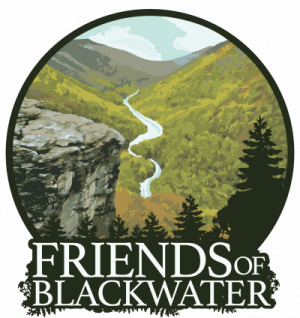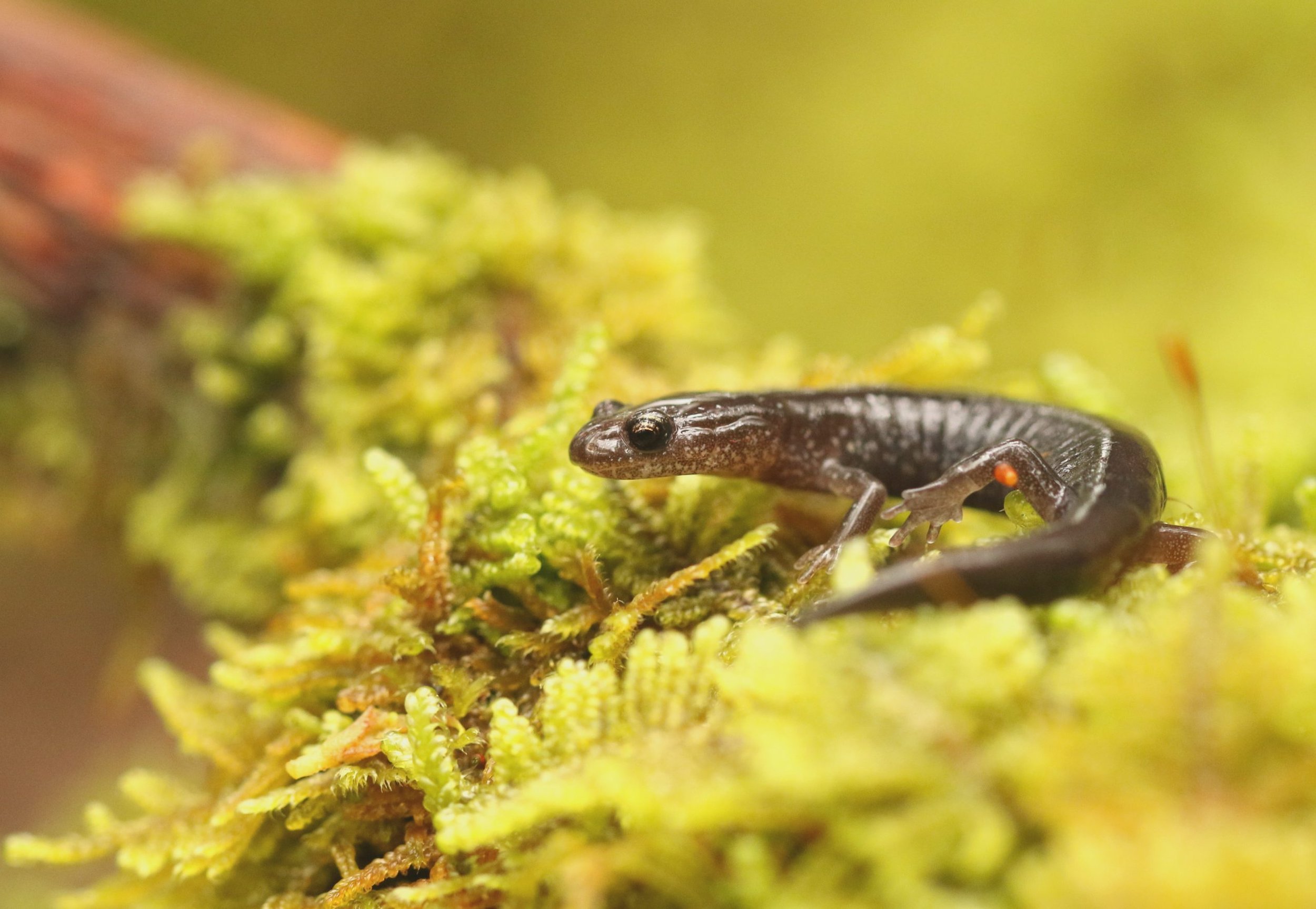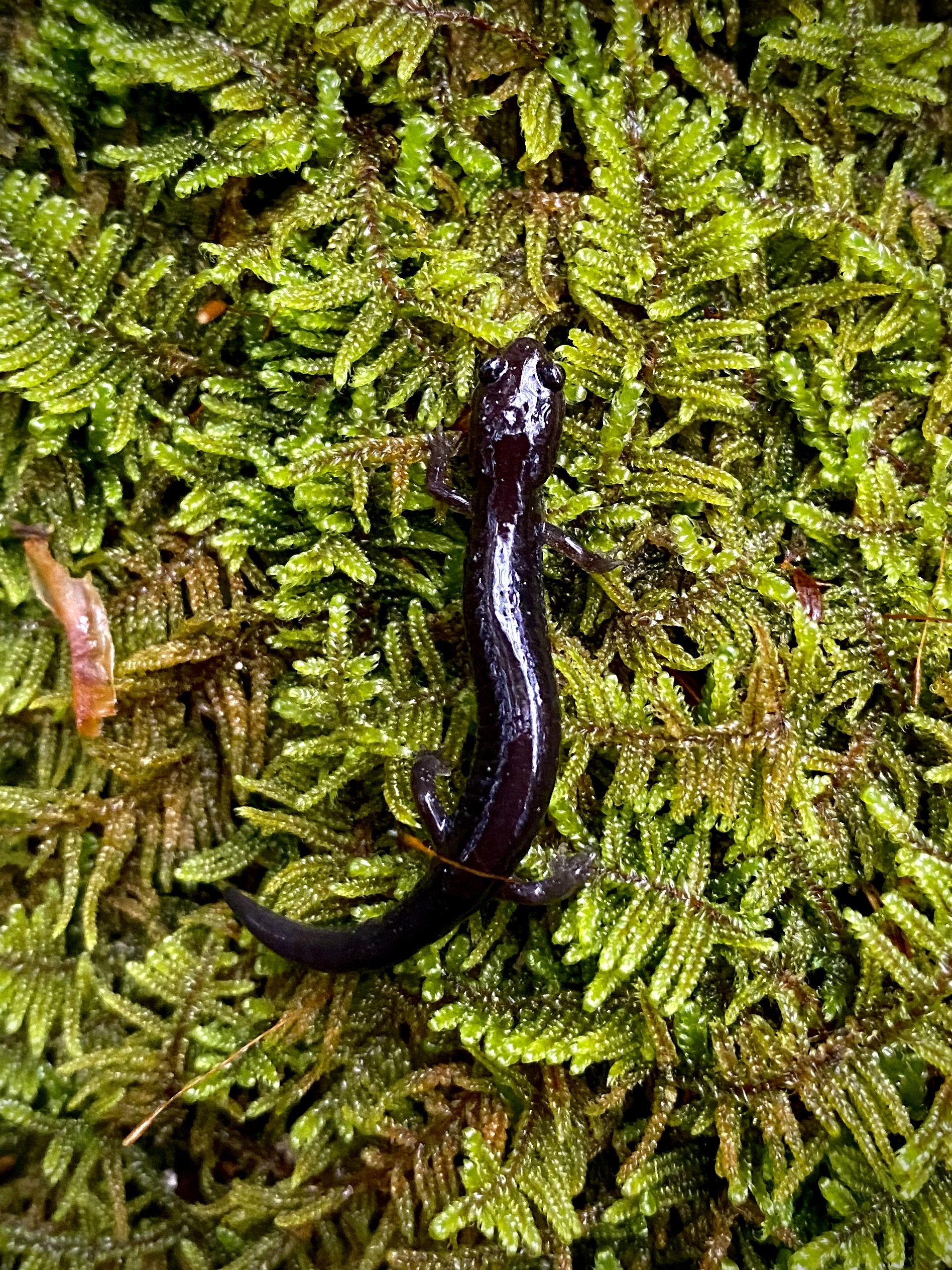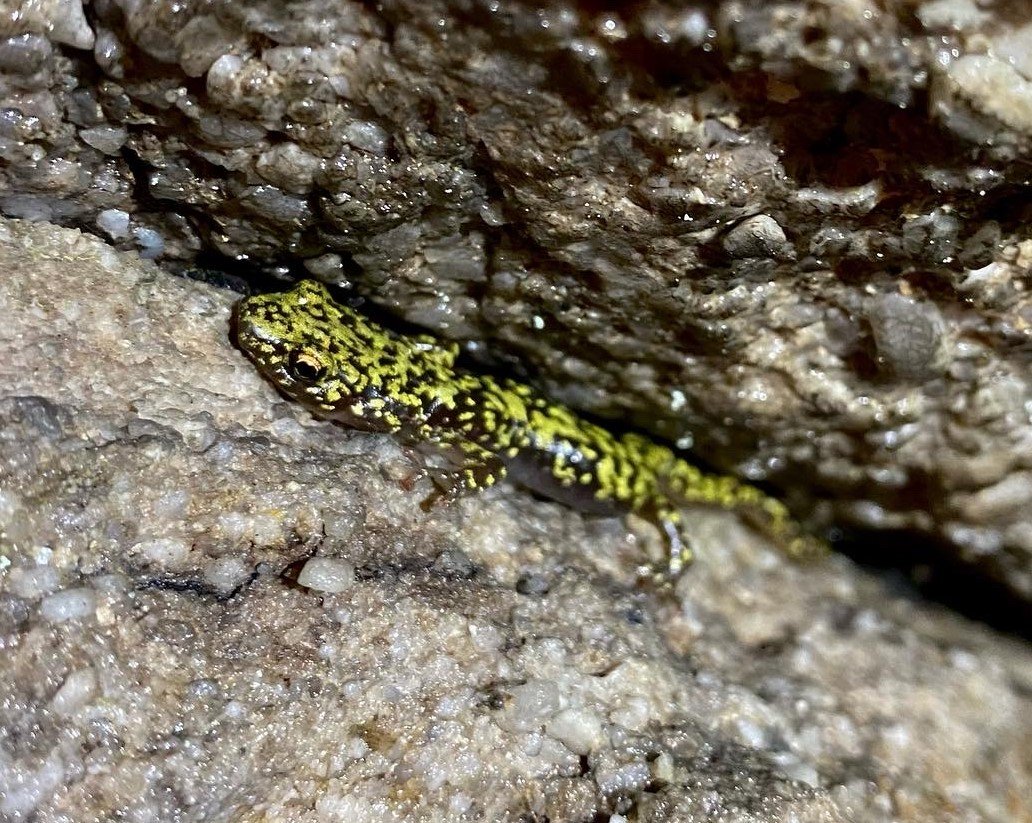
Salamanders
Urodela
(Order)
Plethodontidae
Lungless Salamanders
Cheat Mountain Salamander
Plethodon nettingi
Of all the species of amphibians that can be found in the Blackwater Canyon, this is the most notable. The Cheat Mountain salamander is a high-elevation specialist; occupying the moist, moss-covered floor of the spruce-fir forests in the high Alleghenies. This species can only be found in a few counties in West Virginia and nowhere else on planet Earth! They spend most of their time hidden away underground or under cover objects like rotting logs to avoid desiccation from the hot sun; only emerging on moist nights to forage for their tiny invertebrate prey. This species is federally threatened due to habitat loss from logging and other anthropogenic activities.
Eastern Red-Backed Salamander
Plethodon cinereus
A very common species on the East Coast, the red-backed salamander outweighs all of the mammals in its range. That's right, if you gathered all the red-backed salamanders and all of the mammals (including humans) in their range, the total weight of red-backed salamanders would be heavier! This species is know as what's called a "generalist", meaning they can occupy a number of different habitats, eat many different prey items, and live at various elevations. Unlike the Cheat Mountain salamander that can only live in one habitat type, restricted to high elevations. That being said, they compete with Cheat Mountains for space and food sources, even sometimes fighting to the point of breaking tails off. Red-backed salamanders (as well as all members of the Plethodon genus) exhibit a developmental path differing from most amphibians. Their eggs are laid on land, hatching into miniature versions of their parents and skipping the aquatic larval stage all together. The individuals found in the Blackwater Watershed tend to be more colorful than most populations with red not only on their backs, but on their sides as well. This species can be found from Canada to North Carolina.
Northern Slimy Salamander
Plethodon glutinosus
Another common species found in the Blackwater Watershed is the Northern slimy salamander. This species is aptly named for the slimy mucous they can excrete through their skin as a defense against predators. This mucous can be so sticky that it can temporarily glue its predators mouth shut! This species prefers moist areas covered in moss and spends much of its time hiding beneath the ground in gullies. They exhibit a unique coloration of navy blue with white speckles, indicating they are prepared to defend themselves with that sticky mucous. They can be found from New Hampshire to Georgia.
Wehrle's Salamander
Plethodon wehrlei
Wehrle's ("whirl-ees") salamanders tend to occupy much drier habitats than the other species we see in the Blackwater Watershed. They prefer well-draining hillsides with plenty of stones to hide under with sandy, gravely soil. Wehrle's salamanders exhibit a similar coloration to Northern slimys but lack the white speckles on the back and have more of a cream-colored series of thick speckles on their sides. They are also more of a gray color than navy. This species is wide-spread and can be found from New York to Tennessee, although they are only locally abundant where suitable habitat exists.
Green Salamander
Aneides aeneus
Green salamanders are the most specialized species that calls the Blackwater Canyon its home. Being the East Coast's only arboreal salamander (a species that climbs and occupies off-the-ground habitat). Green salamanders can only be found in rock outcrops, hiding within the tiny crevices during the day to avoid predators and heat. They have flattened bodies and strong toes that allow them to fit in extremely small places where they are safest. These salamanders have a wide range, living all the way from Pennsylvania to Mississippi, however they are so habitat specific they are not commonly seen.
Four-Toed Salamander
Hemidactylium scutatum
Desmognathus ochrophaeus
Desmognathus fuscus
Desmognathus monticola
Gyrinophilus porphyriticus
Eurycea bislineata
Allegheny Mountain Dusky Salamander
Northern Dusky Salamander
Seal salamander
Spring Salamander
Northern Two-Lined Salamander
Members of the Desmognathus genus tend to be tricky to identify due to their high variability in color and pattern. The most varying species in the Blackwater Watershed is without a doubt the Allegheny Mountain dusky salamander. The most common member of its genus in the Allegheny Mountains as its name suggests. Interesting in that salamanders of the Desmognathus genus are usually much more tied to water than their Plethodon cousins, but the Allegheny duskies are the exception. This species can be found occupying habitat fairly far from a water source, only having to venture there to lay their aquatic eggs. Allegheny Mountain dusky salamanders can be seen sporting colors from sulfur yellow to red to muddy brown. They can be distinguished from the other "desmogs" (slang term for salamanders belonging to the Desmognathus genus) by their tail which is round in cross-section, devoid of a keel. Their range extends from New York to Georgia.
Northern dusky salamanders are a bit more tied to water than their Allegheny cousins. A way to distinguish them from Allegheny Mountain duskies is their tail, exhibiting a flattened keel along the top, giving it a tear-drop shape in cross-section. The reason for this partially keeled tail is to help them swim in their semi-aquatic habitat. Northern dusky salamanders are a bit larger than Allegheny Mountain duskies and can only be found sporting different shades of brown. This species lives in muddy seeps and streams in the Blackwater Watershed and can be found widespread from Maine to North Carolina.
Seal salamanders are the most aquatic of the Blackwater Watershed's Desmognathus species. They can be identified by being much larger than the other two as well as their fully keeled tail they use for swimming. This species lives in streams under rocks and emerges at night, hunting for invertebrates along the bank. They can be found from Pennsylvania to Alabama and have been introduced elsewhere by anglers using them as bait.
With the highest biodiversity of salamanders in the world, the Southern Appalachians tend to harbor some very specialized species, exhibiting peculiar behaviors from time to time. The spring salamander is no exception, with a taste for its own kind... well sort of. Spring salamanders specialize in eating smaller species of salamander. They are highly aquatic, occupying cool mountain springs and streams. They are very large for a member of the Plethodontidae family, reaching a maximum length of 7.5 inches! Sometimes they can be seen with a dazzling orange coloration but are usually a salmon/pink color. Spring salamanders rarely venture far from their watery homes, only leaving to hunt for smaller salamanders along the banks of their springs. This species can be found from Maine to Mississippi.
Northern two-lined salamanders are usually found close to water. They live in forests and streams, hiding under stones and logs during the day. They exhibit a beautiful gold coloration with two black lines running down their back (hence the name). These salamanders attach their eggs to submerged stones in streams and guard them until they hatch into gilled larvae. This species is common all the way from Canada to West Virginia, reaching the southern extents of its range in our state.
Four-toed salamanders are quite funky looking, with a constriction at the base of their tail, a square face, and a salt & pepper colored belly; all things that make them very easy to identify! This species is the only member of its genus (Hemidactylium) in the world. A unique behavior they exhibit is communal nesting. This means that females of this species can be found guarding eggs of multiple mothers. The reason they do this is their eggs are bright white to indicate their toxicity, meaning the more eggs around a female the safer she will be (predators recognize their eggs as being poisonous and let them be). Four-toed salamander eggs need to be laid in sphagnum moss. This is because their eggs will drown if laid underwater but cannot dry out. Even more, their eggs hatch into larvae with gills and wriggle down to the water below the moss upon hatching. Truly a wonderful little species of amphibian, they can be found from Canada to the Gulf of Mexico! (but only where they can find that precious sphagnum moss)
Ambystomatidae
Mole Salamanders
Spotted Salamander
Ambystoma maculatum
Members of the lungless salamander family (Plethodontidae) don't reach very impressive sizes, most being fairly small. Now mole salamanders (Ambystomatidae) are a different story, being the largest terrestrial (land-dwelling) salamanders in North America! The spotted salamander is very common throughout the Blackwater Watershed yet rarely seen. These salamanders live up to their family name by spending their days underground in self-made and abandoned burrows. The environment down there is cool and moist, protecting them from the hot sun and predators alike. They only emerge from their burrows on the first warm, rainy night of early spring to migrate to their breeding wetlands called "vernal pools" (temporary wetlands devoid of fish that dry out by late summer). Spotted salamanders are the second largest terrestrial salamander in North America, reaching a maximum size of 10 inches long! They have stout bodies and two rows of bright yellow spots running down their backs. They are a very common species extending from Canada to Texas!
Cryptobranchidae
Giant Salamanders
Eastern Hellbender
Cryptobranchus allegeniensis
Eastern Hellbenders are the largest salamanders in North America as well as the third largest in the world. They have many interesting habits and characteristics. Hellbenders have folds that look like lasagna on their sides that give them more surface area to absorb oxygen from the water. They are in a major decline with an estimated 10-20% of them left. They are at risk of extinction due to habitat destruction from sedimentation and warming temperatures. Hellbenders need large, rocky streams and rivers with nooks and crannies they can fit in but this habitat is becoming rare due to the building of roads, logging, and rock stacking. They are fully aquatic although they lack gills as adults. Some fun nicknames include snot otters, devil dogs, Allegheny alligators, and lasagna lizards!
Pauley, T. K., Pauley, B. A., & Watson, M. B. (2005). Plethodon Nettingi. AmphibiaWeb. Retrieved July 12, 2022, from https://amphibiaweb.org/cgi/amphib_query?where-genus=Plethodon&where-species=nettingi&account=lannoo
AmphibiaWeb 2021 Plethodon cinereus: Eastern Red-backed Salamander <https://amphibiaweb.org/species/4126> University of California, Berkeley, CA, USA. Accessed Jul 12, 2022.
Beamer, D. A., & Lannoo, M. J. (2005). Plethodon glutinosus. AmphibiaWeb. Retrieved July 12, 2022, from https://amphibiaweb.org/cgi/amphib_query?where-genus=Plethodon&where-species=glutinosus&account=lannoo
Pauley, T. K., & Watson, M. B. (n.d.). Plethodon wehrlei. AmphibiaWeb. Retrieved July 12, 2022, from https://amphibiaweb.org/cgi/amphib_query?where-scientific_name=plethodon%2Bwehrlei&rel-scientific_name=contains&include_synonymies=Yes
Pauley, T. K., & Watson, M. B. (n.d.). Aneides aeneus. AmphibiaWeb. Retrieved July 12, 2022, from https://amphibiaweb.org/cgi/amphib_query?where-scientific_name=aneides%2Baeneus&rel-scientific_name=contains&include_synonymies=Yes
Harris, R. N. (n.d.). Hemidactylium scutatum. AmphibiaWeb. Retrieved July 12, 2022, from https://amphibiaweb.org/cgi/amphib_query?where-genus=Hemidactylium&where-species=scutatum&account=lannoo
Pauley, T. K., & Watson, M. B. (n.d.). Desmognathus Ochrophaeus. AmphibiaWeb. Retrieved July 12, 2022, from https://amphibiaweb.org/cgi/amphib_query?where-genus=Desmognathus&where-species=ochrophaeus&account=lannoo
Means, B. (n.d.). Desmognathus fuscus. AmphibiaWeb. Retrieved July 12, 2022, from https://amphibiaweb.org/cgi/amphib_query?where-genus=Desmognathus&where-species=fuscus&account=lannoo
Camp, C. D., & Tilley, S. G. (n.d.). Desmognathus monticola. AmphibiaWeb. Retrieved July 12, 2022, from https://amphibiaweb.org/cgi/amphib_query?where-genus=Desmognathus&where-species=monticola&account=lannoo
Beachy, C. K. (n.d.). Gyrinophilus porphyriticus. AmphibiaWeb. Retrieved July 12, 2022, from https://amphibiaweb.org/cgi/amphib_query?where-genus=Gyrinophilus&where-species=porphyriticus&account=lannoo
Sever, D. M. (n.d.). Eurycea bislineata. AmphibiaWeb. Retrieved July 12, 2022, from https://amphibiaweb.org/cgi/amphib_query?where-genus=Eurycea&where-species=bislineata&account=lannoo
Savage, W. K., & Zamudio, K. R. (n.d.). Ambystoma maculatum. AmphibiaWeb. Retrieved July 12, 2022, from https://amphibiaweb.org/cgi/amphib_query?where-genus=Ambystoma&where-species=maculatum&account=lannoo
AmphibiaWeb 2020 Cryptobranchus alleganiensis: Hellbender <https://amphibiaweb.org/species/3861> University of California, Berkeley, CA, USA. Accessed Nov 9, 2022.




















